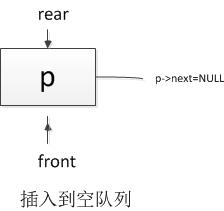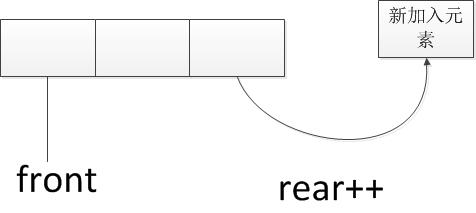佇列的陣列和連結串列實現
阿新 • • 發佈:2019-02-15
1.佇列是先入先出額資料結構,它的實現可以用陣列,也可以用連結串列。用陣列實現連結串列時,需要預先分配陣列的大小,用front和rear下標分別表示隊頭元素下標和隊尾元素下標,插入一個元素時,使隊尾的下標rear加1,刪除一個元素時,front下標加1,判斷是否為空的佇列只要判斷front和rear是否相等。佇列的插入操作可表示為
# include <stdio.h> # include <stdlib.h> # define Maxsize 100 struct queue { int front; int rear; int q[Maxsize]; }; int main() { void initialqueue(queue*); void push(queue *,int); int pop(queue*); int isempty(queue*); int isfull(queue*); queue p; initialqueue(&p); push(&p,1); push(&p,2); push(&p,3); printf("%d\n",isempty(&p)); printf("%d\n",pop(&p)); system("pause"); return 0; } void initialqueue(queue *p) { p->front=p->rear=0; } int isfull(queue *p) { return p->rear==p->front+Maxsize-1; } int isempty(queue *p) { return p->front==p->rear; } void push(queue* p,int x) { if(isfull(p)) { printf("queue is full\n"); exit(-1); } p->q[p->rear++]=x; } int pop(queue *p) { if(isempty(p)) { printf("queue is empty\n"); exit(-1); } return p->q[p->front++]; }
2.連結串列實現佇列
用連結串列實現佇列,需要定義節點結構體儲存節點的值和指標,另外還要定義頭指標和尾指標,分別指向隊頭和隊尾,插入元素的操作可以表示為

# include <stdio.h> # include <stdlib.h> struct node { int num; node *next; }; typedef struct { node *front; node *rear; }link; int main() { void initialqueue(link p); link push(link,int); int pop(link); int isempty(link); int isfull(link); link p={0,0}; initialqueue(p); p=push(p,1); p=push(p,2); p=push(p,3); printf("%d\n",pop(p)); system("pause"); return 0; } void initialqueue(link p) { p.front=p.rear=0; } int isempty(link p) { return p.front==NULL&&p.rear==NULL; } link push(link p,int x) { node *t=(node *)malloc(sizeof(node)); t->num=x; t->next=NULL; if(isempty(p)) { p.front=p.rear=t; } else { p.rear->next=t; p.rear=t; } return p; } int pop(link p) { int temp; node *t; if(isempty(p)) { printf("queue is empty\n"); exit(-1); } if(p.front!=p.rear){ temp=p.front->num; t=p.front; p.front=p.front->next; free(t); } else { temp=p.front->num; t=p.front; p.front=p.rear=NULL; free(t); } return temp; }


